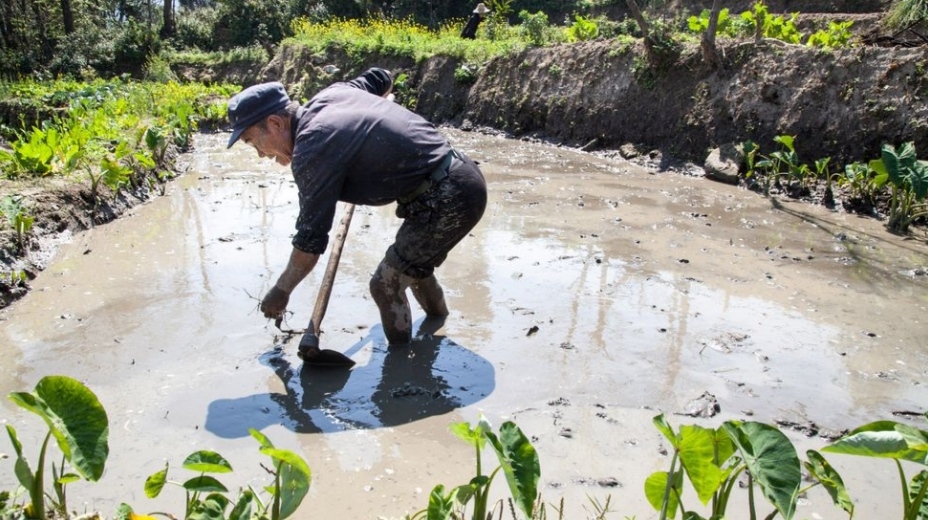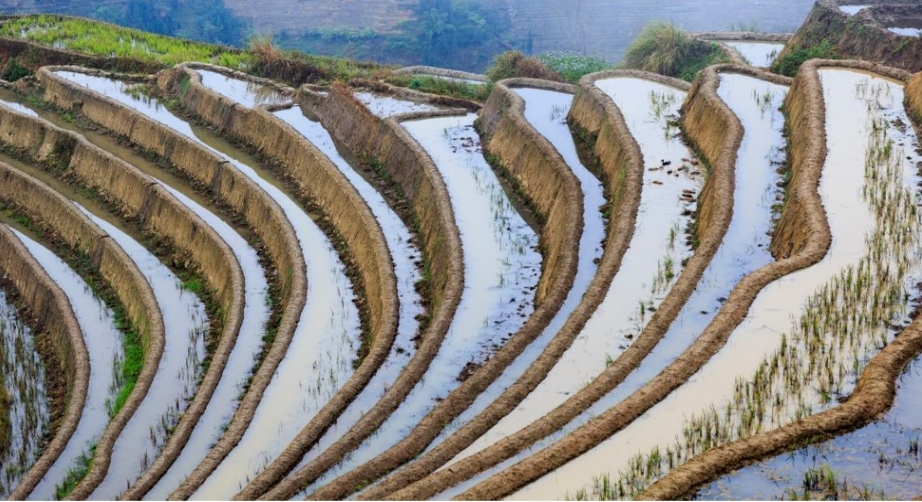The marvel of China’s multi-generational rice terraces

By Gary Jones
Hacked from mountains in south-western China, the sprawling Honghe Hani Rice Terraces stack up over more than 160sq km to create one of the most spectacular landscapes on Earth.
It is often said that the Great Wall of China is the only man-made object visible from space. It’s not true, of course; the crumbling, frequently overgrown structure is mostly no wider than a country road. But if the unaided human eye really can spot some of Earth’s engineered marvels from low orbit, then in China they must surely include the Honghe Hani Rice Terraces.
Hacked from mountains in the country’s south-western Yunnan province, the sprawling terraces – hundreds of thousands of them – stack up over more than 160sq km to create one of the most spectacular and jaw-dropping landscapes on the planet.
What’s more, through the massive, multi-generational engineering project that created the staircase-like terraces, the local Hani people – one of China’s 55 officially recognised ethnic minorities – have harnessed the local environment for the benefit of the entire community.
“Since ancient times, Hani people have built ditches and canals to divert spring water from mountains and forests to irrigate terraced fields,” said A Xiaoying, a Yunnan-based guide with specialist tour company China Highlights. “The amount of ditches required has been huge, needing a great deal of manpower and material resources, which individuals or villages could not afford independently.”
Refined through trial and error over more than a millennium, the rice terraces are an inspiring example of an entire community working symbiotically with nature, with land use arranged by elevation into distinct ecological zones. Rainfall and moisture from dense mountain fog are collected in forested catchment areas high on the slopes, recharging ground water; spring water is channelled to irrigate the terraces; pooled water evaporates to form clouds; and clouds gather to shed rain on the high forests. The hydrologic cycle then repeats ad infinitum.

Hani farmers began carving the terraces out of the mountains during the Tang dynasty
“The Hani people have always lived in harmony with nature, forming a living environment with forests on the top, villages in the middle, terraces lower down and water systems such as rivers running through, thus creating a unique ecosystem of ‘four elements’ – forests, villages, terraces and water systems,” A said.
This strategy offers sustainable benefits not only in rice cultivation, but also in everything from timber, vegetable and fruit production to duck breeding, fish farming and the gathering of herbs employed in traditional medicines. The terraces are, effectively, the Hani’s year-round larder.
“There is water flowing through the engineered landscape all the time,” explained American ethnographer Jim Goodman, author of Yunnan: China South of the Clouds, who has decades of experience interacting with the area’s tribal peoples. “Most other terrace systems elsewhere in the world don’t have that. So, in the winter months, outside of the rice-growing season, the Hani terraces are still useful as a place for fish and frogs, for snails, for good things that the Hani can eat.”
It is believed that the Hani arrived in the Ailao mountains, close to Yunnan’s modern border with Vietnam, around the 3rd Century, having migrated south from the harsh, barren and unforgiving Qinghai-Tibetan plateau. They were so enamoured by what they found there – fertile land, mild climate, plentiful rainfall – they chose to put down roots.
The Hani have engineered the landscape democratically, using a system of channels, dividers and dykes to ensure that the water moves through the space fairly
With more than 80 villages served by the terraces today, water is the commodity that’s not only crucial for the Hani’s survival, but for community cohesion, too. Equality of supply, said Goodman, is the starting point of the group’s success.
“The Hani have engineered the landscape democratically, using a system of channels, dividers and dykes to ensure that the water moves through the space fairly,” he said. “Every village has an official ‘water guardian’, who ensures that the water is distributed evenly. The family whose land is at the bottom of the terrace gets the same water as whoever is at the top.”

The hand-carved terraces slot together like a giant jigsaw puzzle
Viewed from any lofty vantage point, the asymmetrical terraces – some as big as football pitches, others no larger than a casually thrown bed sheet, and all clearly defined by dark, curving walls of compacted mud – slot together like a colossal jigsaw puzzle. In winter and spring, the terraces fill with water to reflect the sky, each resembling a lozenge-like panel in a mighty, swirling stained-glass window.
Hani farmers began carving the terraces out of the mountains during the Tang dynasty (618-907 AD), with their distinctive use of land recounted in handed-down accounts. The terraces have been tended ever since, climbing from riverbank locations at less than 500m above sea level to cloud-shrouded heights of more than 1,800m, and on inclines as steep as 70 degrees. The oft-abused description “stairways to heaven” is most apt here.
Even more impressive, perhaps, is that the terraces have always been carved by hand, and that the construction methods used today are the same as those of the Hani’s ancestors.
“You can’t mechanise the terraces,” explained Goodman. “You can’t use tractors or other machines because of their shape and location. And they’re often knee-deep with water. So, the Hani are still using buffalo or doing the hard work by hand, using the same picks and hoes and hand tools that they’ve used for hundreds of years.”
Despite being gradually extended with each planting season, the Hani’s gargantuan engineering marvel-cum-abstract artwork remained largely hidden from the rest of the world for centuries. A rare outsider account came in the 1890s, when Prince Henri of Orléans led a French expedition from Vietnam to Yunnan, searching for the source of the Irrawaddy River that bisects Burma.
“The hillsides here were covered two-thirds of their height with rice fields, rising in regular terraces, over which water trickled in a series of cascades that glittered like glass in the sun,” Henri wrote, adding, “This method of irrigation was quite a work of art, all the embankments being thrown up by hand or stomped by foot.”
In the early 1920s, American Harry A Franck – one of the foremost travel writers of the time – also slipped into Yunnan from Vietnam, watching from the window as his train chugged through the rugged landscape along the French-built, narrow-gauge railway. “There are terraces everywhere, steeper than stairways, long, but as narrow as they are high, the mountains about them mirrored in new rice fields,” Franck gushed in his book Roving Through Southern China (1925).
But then, kicking off in the 1930s – with China’s long war with Japan, followed by civil war and revolution and the shuttering of the newly communist country behind the so-called “bamboo curtain” – the mountainous region became off limits for foreigners, only reopening in the ’80s.
Nobody paid much attention until the 2000s, with the arrival of new tarmac roads and a local authority determined to get the terraces highlighted on Unesco’s World Heritage List. (This was finally achieved in 2013, the UN agency stating: “The resilient land management system of the rice terraces demonstrates extraordinary harmony between people and their environment, both visually and ecologically.”)
In the past decade, keeping such a topographical oddity under wraps has been impossible, of course, with well-heeled photography enthusiasts – mostly from China’s affluent cities – converging on the flooded terraces during China’s Lunar New Year holiday in late January or early February, capturing the mind-blowing scenes in megapixels and then flooding social media with them.
Though the terraces shimmer a vibrant emerald in the summer growing season (the local micro-climate supports just one rice crop a year, if an abundant one), the landscape is at its most photogenic from November to late April, when the waterlogged terraces become natural mirrors that glow in shades of indigo and tangerine, in gold, turquoise and magenta, with every sunrise and sunset. Farmers and water buffalo occasionally lumber by in pleasing silhouette.
The Hani villages are also postcard-perfect, their squat, ochre-hued houses of adobe and stone topped with mushroom-like thatched roofs. Thumping great black pigs and accompanying farrows of cute piglets roam freely, always accompanied by a reassuring soundtrack of gurgling streams and tinkling irrigation channels.

The multi-generational engineering project spreads over more than 160sq km
Yuanyang county, the home of the terraces, has a population of some 370,000 people, with almost 90% coming from tribal groups. Come bustling market days in villages such as Shengcun, the Hani are joined by their Miao, Yao, Dai, Zhuang and Yi neighbours to trade and attend to regional business, to eat and drink, to gossip and smoke their distinctive, elongated bamboo pipes, the women often decked out in colourful and embroidered tribal costumes and chunky silver jewellery.
Wander 200m from Shencun in any direction, however, and the frantic buying and selling of the market is easily forgotten. Hike the meandering trails through the terraces – or even along their mud walls if nimble on your feet – and you will be absolutely alone.
The Hani can give the world lessons in land management, as well as in how to live in harmony with the environment
In a time of shrinking natural resources globally, Goodman says the Hani can give the world lessons in land management, as well as in how to live in harmony with the environment.
“They are proud of what they’ve achieved,” he said. “They accomplished something marvellous that has held firm for possibly 1,300 years.”
He added: “Show them a photo you took of Hani people dressed up in their traditional clothes, with their fancy jewellery and whatnot, and they’ll shrug. Show them a picture of the rice terraces and you’ll get a big smile and a thumbs-up.”
Source : BBC Travel




